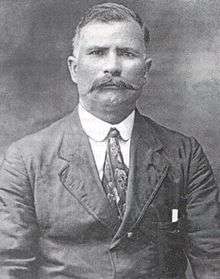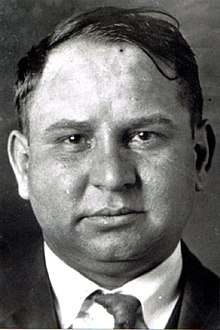Nicolo Schiro
| Nicolo Schiro | |
|---|---|
|
Schiro, 1923 | |
| Born |
September 2, 1872 Roccamena, Sicily, Italy |
| Died |
April 29, 1957 (aged 84) Camporeale, Sicily, Italy |
| Nationality | Italian, American (renounced citizenship) |
| Other names | "Cola" |
| Occupation | Crime boss, mobster |
| Allegiance | Schiro Crime Family |
Nicolo "Cola" Schiro or Nicola Schiro (September 2, 1872 – April 29, 1957) was an early Sicilian-born New York City mobster. In 1912, he became the boss of the mafia gang that later became known as the Bonanno crime family. After nearly two decades as boss, a conflict with rival gangster Joe Masseria in 1930 would force Schiro out and elevate Salvatore Maranzano as his replacement. Following his ouster, Schiro returned to Sicily.
Early life
Nicolo Schiro was born on September 2, 1872 in the town of Roccamena, in the Province of Palermo, Sicily to Matteo Schiro and his wife, Maria Antonia Rizzuto. Nicolo was named after his paternal grandfather, a mayor of Roccamena in the 1840s who came from the Arbëreshë community of Contessa Entellina.[1]
A few years later, Schiro's family moved to his mother's hometown in nearby Camporeale.[1] Paolo Orlando, a cousin born in Camporeale, reportedly became a mafia boss in the large Italian community of the French colony of Tunis.[2][3] Schiro immigrated to the United States in 1897,[1] and by 1902 had settled in the Williamsburg section of Brooklyn.[4]
Mafia boss

In 1912, Schiro replaced Sebastiano DiGaetano as the head of the local mafia centered in Williamsburg.[2] DiGaetano, an immigrant from the Sicilian town of Castellammare del Golfo, had gained notoriety two years earlier after being arrested as a suspect in the kidnappings of eight-year old Giuseppe Longo and seven-year old Michael Rizzo for ransom.[5][6] Salvatore Clemente, a Secret Service informer in the Morello gang, claimed that DiGaetano was stepping down because he had "lost his nerve." Shortly after Schiro became boss, DiGaetano diappeared.[1] Schiro's elevation to boss may have been helped by the presence in Brooklyn of his cousin, Orlando, who reportedly had been forced to leave Tunis.[3] Orlando remained in Brooklyn until the end of World War I.[7]
At this time another mafia boss in New York City, Salvatore D'Aquila, was bestowed the title Capo dei capi by other mafiosi. Clemente told his Secret Service handlers in November 1913 that Schiro was aligned with the Morello gang in a war against D'Aquila.[8] A truce seems to have been called between the factions by the end of the year which held until the May 23, 1914, murder of Fortunato LoMonte under D'Aquila's orders. LoMonte had taken over the Morello gang after Giuseppe Morello's 1910 conviction for counterfeiting. After the killing started again, Schiro maintained a neutral position, siding with neither the D'Aquila gang nor the Morello gang.[9]
Schiro ran the gang in a conservative manner, conducting its criminal activity primarily among Sicilian immigrants. He avoided attention from authorities and co-operating with other non-Sicilian gangs; while developing close relationships with local political leaders.[10][11]
Schiro became naturalized as a United States citizen in 1914.[12]
"The Good Killers"

On August 16, 1921, Vito Bonventre, Stefano Magaddino, and four other gangsters were arrested for the murder of Camillo Caiozzo a couple of weeks earlier.[13] They were arrested after the confession of Bartolo Fontana, the gunman who had shot and killed Caiozzo. Fontana identified the men as members of the "Good Killers," a group of mafioso from Castellammare del Golfo that were leading members of the Schiro gang. Fontana said they ordered him to kill Caiozzo in retaliation for the 1916 murder of Magaddino's brother, Pietro, in Sicily. He also revealed that the "Good Killers" were responsible for a string of other murders.[13] Some of the victims he named were connected to the Buccellato family who ran a mafia clan in Castellammere del Golfo that was opposed to the one run by the families of Bonventre and Magaddino back in their hometown.[14]
Other victims were former supporters of Salvatore Loiacano, who had been backed by Salvatore D'Aquila to take over the Morello crime family. Loiacano was murdered on December 10, 1920, not long after Morello was released from prison. According to an article in the New York Evening World, seven men placed their hands on Loiacano's corpse and vowed revenge. Within a few months, three of the vow makers - Salvatore Mauro, Angelo Patricola, and Giuseppe Granatelli had been murdered and a fourth, Angelo Lagattuta was shot and severely wounded. They were all named by Fontana as victims of the "Good Killers," with Fontana unaware that Lagattuta had survived. Morello had made a deal with Schiro to kill Loiacano's supporters with people unfamiliar to them.[15]
The government's case against the "Good Killers" collapsed with only Fontana's testimony against them. Fontana went to prison for Caiozzo's murder and the others were released. Magaddino fled New York City after his release, ending up in Buffalo, New York.[16]
1920s and Prohibition
Schiro eschewed the media and was never arrested for a crime during his time as boss.[10] Several former members of the Schiro crime family would become the bosses of gangs in other cities – Frank Lanza in San Francisco, Stefano Magaddino in Buffalo, and Gaspare Messina in New England.[17]
Giovanni Battista Dibella, a member of Schiro's gang, was arrested (under the alias Piazza) on July 14, 1921, when over $100,000[lower-alpha 1] worth of whiskey and numerous faked liquor withdrawal permits were seized during a raid by Federal agents at his olive oil warehouse at 177 Boerum Avenue in Brooklyn.[19][20] Schiro had been a witness at Dibella's wedding in 1912.[21] On September 12, 1922, Dibella's brother, Salvatore, was arrested (also under the alias Piazza) for killing 17 year-old Gutman Diamond, a messenger for Western Union, while shooting at another bootlegger.[22][23]
Salvatore Maranzano, son-in-law of a mafia boss in Trapani, arrived from Italy in 1924. Born in Castellammare del Golfo, he joined the Schiro gang with its large contingent of members from there. He quickly established an extensive bootlegging network in Dutchess County, New York.[24]
Conflict with Masseria

Salvatore D'Aquila was killed on October 10, 1928.[25] Joe Masseria, the leader of a gang that emerged from the old Morello crime family, was selected to replace D'Aquila as the new Capo dei capi that winter.[26] After his elevation, Masseria began applying pressure to other mafia gangs for monetary tributes.[27] Other mobsters accused him of orchestrating the 1930 murders of Gaspar Milazzo in Detroit and Gaetano Reina in the Bronx. Schiro tried to replicate the strategy of neutrality he used to deal with D'Aquila with Masseria but he was vigorously opposed by Maranzano and Buffalo boss Stefano Magaddino.[28] Masseria claimed Schiro had committed a transgression and demanded Schiro pay him $10,000[lower-alpha 2] and step down as leader of his mafia crime family. Schiro complied. Soon after, Vito Bonventre was murdered at his home on July 15, 1930.[29] This led to Maranzano being elevated to boss of the gang and a conflict with Masseria and his allies referred to as the Castellammarese War.[30]
Return to Sicily
After Schiro's ouster as boss in 1930, he returned to Italy; settling in his old hometown of Camporeale in Sicily. In 1934, Schiro dedicated a memorial in Camporeale to Italian soldiers killed during World War I.[31] Schiro renounced his U.S. citizenship at the American consulate in Palermo on October 14, 1949.[12]
Schiro died in Camporeale on April 29, 1957.[32]
In 1999, Schiro was portrayed by Walter Massey in the television movie Bonanno: A Godfather's Story.[33]
See also
Notes
References
Citations
- 1 2 3 4 Warner, Santino & Van't Reit 2014, p. 55.
- 1 2 Warner, Santino & Van't Reit 2014, pp. 54–55.
- 1 2 Petacco 1974, pp. 168–169.
- ↑ Critchley 2009, p. 214.
- ↑ Warner, Santino & Van't Reit 2014, p. 54.
- ↑ "Police Reserves Guard Italian Gang Members From Angry Crowds: Alleged Kidnappers Arraigned in the Fifth Ave. Court and Each is Held in $10,000 Bail - Longo Child As Accuser, Tot Points Out Those Responsible for His Detention in the Sixty-third Street House". Brooklyn Daily Eagle. 9 December 1910. Retrieved 17 February 2016 – via Newspapers.com.
- ↑ Warner, Santino & Van't Reit 2014, p. 52.
- ↑ Dash, Mike (2009). The First Family: Terror, Extortion and the Birth of the American Mafia. London: Simon & Schuster.
- ↑ Warner, Santino & Van't Reit 2014, pp. 59–61.
- 1 2 Critchley 2009, p. 137.
- ↑ "Hasenpflug Ball 19th A.D. Event: Whole District Turns Out to Do Honor to Democratic Leader; Politics Take Back Place; Palm Garden Gaily Decorated for Event- Cabaret an Enjoyable Feature". Brooklyn Daily Eagle. 1 February 1915. Retrieved 20 March 2016 – via Newspapers.com.
- 1 2 Critchley 2009, p. 311n127.
- 1 2 Hunt, Thomas; Tona, Michael A. (2007). "The Good Killers: 1921's Glimpse of the Mafia". The American Mafia. Retrieved 17 February 2016.
- ↑ Critchley 2009, pp. 216–229.
- ↑ Warner, Santino & Van't Reit 2014, p. 64.
- ↑ Critchley 2009, pp. 216–222.
- ↑ Warner, Santino & Van't Reit 2014, pp. 55–56.
- 1 2 "CPI Inflation Calculator". www.bls.gov. Retrieved 2018-04-19.
- ↑ Schmitt 2012, pp. 58–59.
- ↑ "$100,000 Liquor Raid Staged At Piazzo's, 'Hooch' Alleged to Have Been Withdrawn With Forged Permits". Brooklyn Daily Eagle. 15 July 1921. Retrieved 17 February 2016 – via Newspapers.com.
- ↑ Schmitt 2012, p. 59.
- ↑ Schmitt 2012, pp. 59–60.
- ↑ "Piazza Gets Term of 3 Years in Jail". Brooklyn Daily Eagle. 2 April 1923. Retrieved 17 February 2016 – via Newspapers.com.
- ↑ Critchley 2009, pp. 144–147.
- ↑ Critchley 2009, p. 157.
- ↑ Hortis 2014, p. 74.
- ↑ Hortis 2014, pp. 80–81.
- ↑ Bonanno & Lalli 1983, p. 96.
- ↑ "Wealthy Baker Slain; Police Hint at Mafia: 2 Men Seen Running From Place". Brooklyn Daily Eagle. 15 July 1930. Retrieved 3 March 2016 – via Newspapers.com.
- ↑ Hortis 2014, p. 79–81.
- ↑ Accardo, Luigi (1995). Camporeale: Origini, Usi, Costumi, Mentalita, Proverbi, Canti popolari (in Italian). Alcamo, Sicily: Edizioni Campo. pp. 54–55.
- ↑ Warner, Santino & Van't Reit 2014, p. 53.
- ↑ "Bonanno: A Godfather's Story | Full Cast and Credits | 1998". Hollywood.com. 5 February 2015. Retrieved 24 July 2016.
Sources
- Bonanno, Joseph; Lalli, Sergio (1983). A Man of Honor: The Autobiography of Joseph Bonanno. New York: Simon & Schuster.
- Buccellato, James A. (2015). Early Organized Crime in Detroit: Vice, Corruption and the Rise of the Mafia. Charleston: The History Press. ISBN 9781625855497.
- Critchley, David (2009). The Origin of Organized Crime in America: The New York City Mafia, 1891-1931. New York: Routledge.
- Hortis, C. Alexander (2014). The Mob and the City. Amherst, New York: Prometheus Books.
- Hunt, Thomas (2016). Wrongly Executed? - The Long-forgotten Context of Charles Sberna's 1939 Electrocution. Whiting, Vermont: Seven Seven Eight. ISBN 9781365528729.
- Petacco, Arrigo (1974). Joe Petrosino. Trans. by Charles Lam Markmann. New York: MacMillan Publishing.
- Schmitt, Gavin (July 2012). "The Underworld's Interest in Wisconsin's Cheese". Informer: The History of American Crime and Law Enforcement: 56–65.
- Warner, Richard; Santino, Angelo; Van't Reit, Lennert (May 2014). "Early New York Mafia: An Alternative Theory". Informer: The History of American Crime and Law Enforcement.
External links
- Struggle for Control - The Gangs of New York, article by Jon Black at GangRule.com
| American Mafia | ||
|---|---|---|
| Preceded by Sebastiano DiGaetano |
Bonanno crime family Boss 1912–1930 |
Succeeded by Salvatore Maranzano |